
Palice Mechanical Keyboard+
prusaprinters
<p>Yes I know my keyboard looks awful</p> <p>These models were revised to better accommodate a fully 3D printed build and hand soldering, though it should still work with existing plates and PCBs.</p> <p>After attempting to make the Palice Keyboard by Synyster1911, I was pretty displeased by some errors in the model, which involved remodeling some of the parts. The Original Palice Keyboard also did not involve any bill of materials or recommendations for putting it together, this remix will include some instructions if you haven't done anything like this before (like myself).</p> <p>Updates to the original Palice Keyboard include:</p> <ul> <li>Plates for Plate Mounted Stabilizers</li> <li>New Anchor points for plates (previous ones were too flimsy)</li> <li>Fixing holes to better accommodate the M3 threaded inserts in the covers</li> <li>General fixes to the plates (Caps Lock cut-out is bad on original)</li> <li>General Build guide and print settings</li> <li>Included an additional mount for a female USB C port which replaces the nut and washer for the foot mount: <a href="https://www.aliexpress.com/item/4000903027628.html?spm=a2g0s.9042311.0.0.27424c4dtWP59T">AliExpress Link</a></li> <li>Lower angle with smaller feet brings down the angle of the keyboard from 6 degrees to 3 degrees</li> </ul> <p>Bill of Materials:</p> <ul> <li>M3 Threaded Inserts (5 mm long) x (24 or 16 depending on how sturdy you want your plate)</li> <li>(M3 x 5 mm) x (16 or 8 depending on how sturdy you want your plate)</li> <li>(M3 x 8 mm) x (6 only if you are using the "low feet")</li> <li>(M3 x 12 mm) x (8 or 14 if you are using the regular feet)</li> <li>M3 Nuts x 6</li> <li>M3 Washers x 6</li> <li>Switches x 64</li> <li>Keycaps: Requires a 2.25u and 2.75u spacebar, otherwise uses standard keys. I personally bought this set on AliExpress which came with everything: <a href="https://www.aliexpress.com/item/1005001472239361.html?spm=a2g0s.9042311.0.0.4a784c4dKp1eWE">AliExpress Link</a></li> </ul> <p>I bought most of this off AliExpress, for a decent price, especially the fasteners and inserts. Get extra if you can, I had a few inserts with bad tolerances or just broke.</p> <p>TEST EVERYTHING BEFORE YOU INSTALL, I learned this the hard way, even the screws and threaded inserts, just make sure they screw together easily.</p> <p>When installing the inserts make sure to change the tip of your soldering iron to one that doesn't go through the insert. If the soldering iron melts the plastic at the bottom of the hole, it can flow up into the insert and gum up the threads.</p> <p>If you've had plastic get into the threads, I found that partly screwing in a screw and heating it with the soldering iron, while tightening, can force the plastic out of the threads. You do need to be careful as overheating the screw can heat up the insert again and cause it to torque out while tightening.</p> <p>If there's enough space between the screw and the insert threads the plastic may get in between, letting the plastic solidify and taking out the screw, sometimes removed the plastic in the threads.</p> <p>When printing the plates (if you are using the 3D printed plates) make sure that your bed is level, high or low spots can affect the tolerance for switches, so they may be too snug or too loose. Currently the holes for the switches are 0.2 mm oversized, which I found worked best for fitment.</p> <h3>Print Settings</h3> <p><strong>Printer Brand:</strong></p> <p>Creality</p> <p><strong>Printer:</strong></p> <p>Ender 3</p> <p><strong>Rafts:</strong></p> <p>No</p> <p><strong>Supports:</strong></p> <p>No</p> <p><strong>Resolution:</strong></p> <p>200</p> <p><strong>Infill:</strong></p> <p>Should be fairly high >40%</p> <p><strong>Filament:</strong> Whatever's Cheapest PLA</p> <p><strong>Notes:</strong></p> <p>For any part with a threaded insert, use 4 walls, the inserts can torque out pretty easily if they don't have enough "meat" to bite into. The same goes for the plates, use 4 walls, it helps to strengthen the holes for the switches.</p> <h3>Post-Printing</h3> <p><strong>Quality Control, Additional Parts, and some Puting Together</strong></p> <p>Make sure all the pieces sit flush with each other, and sand/file down the pieces until they do.</p> <p>Assembly Involves installing the threaded inserts into the top covers only, putting an insert in every hole. Unfortunately, the bottom case must be glued together; Synyster1911 said they glued the contact surfaces of the bottom case, but I would recommend gluing a thin rigid plate to connect both bottom cases.</p> <p>The USB C mount is supposed to have the threaded inserts installed on the bottom holes and takes the place of two nut and washers. I linked a USB C breakout board - if you're savvy enough to want to install it you should be able to figure it out how to install it. This only really works if you're hand wiring it like I was, where I essentially cut the end of the USB cord for a teensy 2.0 and soldered the ends to the USB C board.</p> <p>The PCB legs on the breakout board also needed to be cut so that the port end could sit flush against the recess in the back. Before epoxying or gluing the USB C board in place in the mount make sure that its properly wired up and works.</p> <p>Hand Soldering this board was my first-time hand soldering, I made many mistakes, and some parts of this keyboard are held together with tape and hope. I used a Teensy 2.0 and QMK for firmware. Because I installed the switches and soldered all of them before re-designing the plates, I needed to improvise to get the rigidity I wanted (hence the weird screws in the picture below).</p> <p><strong>Here is my terrible attempt at hand soldering and wiring (Be gentle it's my first time). You may notice some weird screws, these were installed because the board was too flimsey; the desings that you download have holes were these weird screws are.</strong></p> Category: Electronics
With this file you will be able to print Palice Mechanical Keyboard+ with your 3D printer. Click on the button and save the file on your computer to work, edit or customize your design. You can also find more 3D designs for printers on Palice Mechanical Keyboard+.
